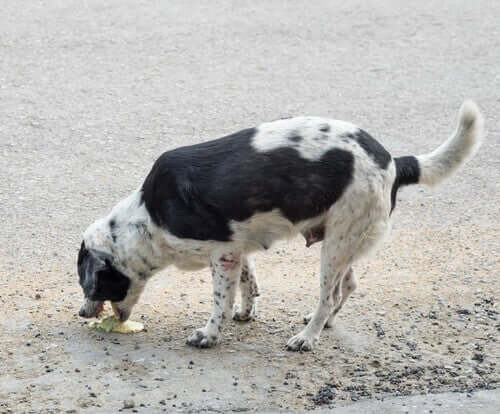Different Types of Dog Vomit: What to Look For


Written and verified by biochemistry Luz Eduviges Thomas-Romero
When dogs throw up, it’s not only a great cause of worry for their owners but also a very unpleasant experience for the dogs themselves. Clearly, dog vomit can have a number of different causes and can indicate a wide variety of conditions. Keep reading the article below to find more information about this common problem.
Dogs throw up for a variety of reasons. Some of the causes are serious while others are no reason for concern. Having said this, learning to recognize the difference can be complicated. To be safe, it’s best to seek veterinary attention as soon as possible to rule out any serious underlying problem.
One important point to keep in mind is that dog vomit and regurgitation are two different things.
The difference between regurgitation and vomiting in dogs
Dog vomit can contain yellow bile or food that has been partially digested. In general, it smells sour because of the presence of stomach acid. Furthermore, vomiting can occur hours after a dog has eaten. The act of vomiting involves gagging and the visible participation of the abdominal muscles.
On the other hand, in the case of regurgitation, the expulsion of undigested food occurs in a less violent fashion. It’s a passive act, without the presence of gagging. It often takes place soon after a dog eats and the act doesn’t require any apparent effort.

The reasons why dogs vomit
While dogs may throw up for many different reasons, gastrointestinal problems are perhaps the biggest cause for dog vomit. These problems include the following:
- Viral, bacterial, or parasitic infections.
- Gastritis or an upset stomach as a result of eating junk food, a foreign object, or spoiled food. It can also be a consequence of the ingestion of toxic plants or grass.
- Poor habits, like eating too fast, exercising right after eating, or abrupt changes in a dog’s diet can also explain dog vomit.
Other illnesses that can cause dogs to vomit
Dog vomit can also be a sign that something more serious is going on. For example, vomiting in canines can be a side effect having to do with inflammatory bowel disease. What’s more, it can also be a sign of problems with a dog’s kidneys, liver, or pancreas, as well as intestinal cancer.
It’s worth pointing out that dog vomit can also be an indication of a neurological problem. In the same way, it can be a sign or a problem with a dog’s inner ear, a brain tumor, and even meningitis.
In fact, the reason for a dog’s vomiting can even be psychological. Just as in human beings, dogs can vomit as a result of fear or extreme anxiety.
The consistency of dog vomit
By observing a dog’s vomit, we can discover its consistency. If, upon observing its consistency, you can distinguish the food a dog has eaten, it means the animal has thrown up food it hasn’t digested. However, if you are unable to distinguish the content of the dog vomit, and it has a creamy consistency, then we call it granular. In addition, a dog’s vomit can be mostly liquid or watery.
- Chunky vomit, or vomit containing undigested food. It’s common for dogs to digest their food without digesting as a result of abrupt changes in their diet. It can also be the result of excessive eating, allergies, or intolerances to certain ingredients in their food, such as excess fat components. In this case, it’s a good idea to keep an eye on the animal’s eating.
- Granular vomit: This creamy consistency suggests that digestion did take place and that the food remained in the stomach for some time before the vomiting occurred. It’s especially important to observe whether or not there is blood in the dog’s vomit.

The color of dog vomit
- Yellow-colored vomit: If a dog’s vomit is yellowish in color, it may be due to an increase in bile production or in the production of stomach acid. In this case, it’s best to offer smaller portions of food and feed your dog more frequently throughout the day.
- If a dog’s vomit is white and foamy: If your dog is throwing up white foam, this may not actually be vomit. Rather, your dog might simply be expectorating, just like when humans cough up phlegm. This foamy white substance may be an indication that your dog has kennel cough.
- Vomit with blood (red or blackish in color): This can be a sign of a serious condition. In this case, you should seek veterinarian assistance right away.
How is liquid vomit different?
In general, liquid vomit that’s yellow or transparent is a sight of a completely different medical problem. In this case, the vomiting has nothing to do with the food your dog has eaten.
Often, the liquid that appears in dog vomit comes from issues with an animal’s organs. For example, the liver, kidneys, or pancreas. It can also be a sign of severe gastritis. Whatever the case, your dog requires medical attention.
When dogs throw up, it’s not only a great cause of worry for their owners but also a very unpleasant experience for the dogs themselves. Clearly, dog vomit can have a number of different causes and can indicate a wide variety of conditions. Keep reading the article below to find more information about this common problem.
Dogs throw up for a variety of reasons. Some of the causes are serious while others are no reason for concern. Having said this, learning to recognize the difference can be complicated. To be safe, it’s best to seek veterinary attention as soon as possible to rule out any serious underlying problem.
One important point to keep in mind is that dog vomit and regurgitation are two different things.
The difference between regurgitation and vomiting in dogs
Dog vomit can contain yellow bile or food that has been partially digested. In general, it smells sour because of the presence of stomach acid. Furthermore, vomiting can occur hours after a dog has eaten. The act of vomiting involves gagging and the visible participation of the abdominal muscles.
On the other hand, in the case of regurgitation, the expulsion of undigested food occurs in a less violent fashion. It’s a passive act, without the presence of gagging. It often takes place soon after a dog eats and the act doesn’t require any apparent effort.

The reasons why dogs vomit
While dogs may throw up for many different reasons, gastrointestinal problems are perhaps the biggest cause for dog vomit. These problems include the following:
- Viral, bacterial, or parasitic infections.
- Gastritis or an upset stomach as a result of eating junk food, a foreign object, or spoiled food. It can also be a consequence of the ingestion of toxic plants or grass.
- Poor habits, like eating too fast, exercising right after eating, or abrupt changes in a dog’s diet can also explain dog vomit.
Other illnesses that can cause dogs to vomit
Dog vomit can also be a sign that something more serious is going on. For example, vomiting in canines can be a side effect having to do with inflammatory bowel disease. What’s more, it can also be a sign of problems with a dog’s kidneys, liver, or pancreas, as well as intestinal cancer.
It’s worth pointing out that dog vomit can also be an indication of a neurological problem. In the same way, it can be a sign or a problem with a dog’s inner ear, a brain tumor, and even meningitis.
In fact, the reason for a dog’s vomiting can even be psychological. Just as in human beings, dogs can vomit as a result of fear or extreme anxiety.
The consistency of dog vomit
By observing a dog’s vomit, we can discover its consistency. If, upon observing its consistency, you can distinguish the food a dog has eaten, it means the animal has thrown up food it hasn’t digested. However, if you are unable to distinguish the content of the dog vomit, and it has a creamy consistency, then we call it granular. In addition, a dog’s vomit can be mostly liquid or watery.
- Chunky vomit, or vomit containing undigested food. It’s common for dogs to digest their food without digesting as a result of abrupt changes in their diet. It can also be the result of excessive eating, allergies, or intolerances to certain ingredients in their food, such as excess fat components. In this case, it’s a good idea to keep an eye on the animal’s eating.
- Granular vomit: This creamy consistency suggests that digestion did take place and that the food remained in the stomach for some time before the vomiting occurred. It’s especially important to observe whether or not there is blood in the dog’s vomit.

The color of dog vomit
- Yellow-colored vomit: If a dog’s vomit is yellowish in color, it may be due to an increase in bile production or in the production of stomach acid. In this case, it’s best to offer smaller portions of food and feed your dog more frequently throughout the day.
- If a dog’s vomit is white and foamy: If your dog is throwing up white foam, this may not actually be vomit. Rather, your dog might simply be expectorating, just like when humans cough up phlegm. This foamy white substance may be an indication that your dog has kennel cough.
- Vomit with blood (red or blackish in color): This can be a sign of a serious condition. In this case, you should seek veterinarian assistance right away.
How is liquid vomit different?
In general, liquid vomit that’s yellow or transparent is a sight of a completely different medical problem. In this case, the vomiting has nothing to do with the food your dog has eaten.
Often, the liquid that appears in dog vomit comes from issues with an animal’s organs. For example, the liver, kidneys, or pancreas. It can also be a sign of severe gastritis. Whatever the case, your dog requires medical attention.
All cited sources were thoroughly reviewed by our team to ensure their quality, reliability, currency, and validity. The bibliography of this article was considered reliable and of academic or scientific accuracy.
- Elwood, C., Devauchelle, P., Elliott, J., Freiche, V., German, A. J., Gualtieri, M., … & Roura, X. (2010). Emesis in dogs: a review. Journal of Small Animal Practice, 51(1), 4-22.
- Grahame-Smith, D. G. (1986). The multiple causes of vomiting: Is there a common mechanism?. In Nausea and Vomiting: Mechanisms and Treatment (pp. 1-8). Springer, Berlin, Heidelberg.
This text is provided for informational purposes only and does not replace consultation with a professional. If in doubt, consult your specialist.








